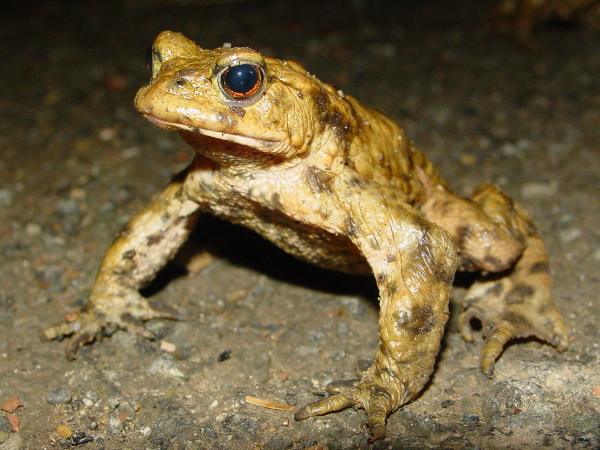Welcome to the Amphibian Pond
Introduction - Species list - Links - Reference SourcesFrogs, toads and newts are four-limbed, cold-blooded animals; this means that their body temperature is determined solely by their environment.
Born from eggs laid in water, amphibians have the amazing ability to change (metamorphose) from a water-breathing juvenile form to an air-breathing adult form. In fact frogs can also breathe through their skin, which allows them to hibernate through the winter months beneath piles of rotting vegetation under the water and even buried in mud.
Although they evolved from fishes many millions of years ago, amphibians look quite unlike most fish species. They are more often confused with reptiles - the latter, however, have no aquatic stage in their life cycle.
Species featured on this site:

Rana
temporaria
Most toads have dry warty skins and spend very little of their adult lives in water, whereas frogs tend to have smooth moist skin and spend more of their adult lives in or close to water; however, there are several exceptions and the distinction between toads and frogs is certainly not based on any taxonomic justification. Frogs are distributed across several families within the order Anura, whereas true toads all belong to one family within that order, the Bufonidae.
A bit more about Amphibians

In recent years experts who specialise in this subject (known as herpetologists) have come to realise that all around the world amphibian populations are declining rapidly. The situation is so serious that on a global scale something like a third of all amphibian species are now faced with the threat of extinction. The usual culprits - habitat loss and water pollution - are only part of the problem. Climate change adds pressure, too, and in addition many amphibian populations are being wiped out by disease.
What can we do about it? Well, one simple and very obvious answer is to create new habitats where frogs, toads and newts can find clean water, plenty of insect life, and the vegetation cover that they need to avoid excessive predation. Garden ponds are wonderful in this respect and surprisingly easy and inexpensive to make! See our online guide to Making a Garden Pond...
Here at First Nature our own garden pond is a wildlife haven, thronging through the spring, summer and autumn with a succession of colourful and fascinating insects including dragonflies, damselflies and beetles, and with a diversity of aquatic and marginal wildflowers such as Fringed Water-lilies, Flag Irises, Bogbean and Marsh Cinquefoil. The frogs, newts and toads love it in and around our garden pond, and we enjoy watching and listening to them on summer evenings.
If you have even the smallest of gardens, build a pond and you will be surprised just how quickly amphibians move in and show their gratitude.
Links to other Amphibian Websites:
Government Agencies active in amphibian conservation include:
Reference Sources
Matching the Hatch by Pat O'Reilly (2017) - learn all about aquatic insects and other small water creatures that feature in the diet of amphibians.
Please Help Us: If you have found this information interesting and useful, please consider helping to keep First Nature online by making a small donation towards the web hosting and internet costs.
Any donations over and above the essential running costs will help support the conservation work of Plantlife, the Rivers Trust and charitable botanic gardens - as do author royalties and publisher proceeds from books by Pat and Sue.






